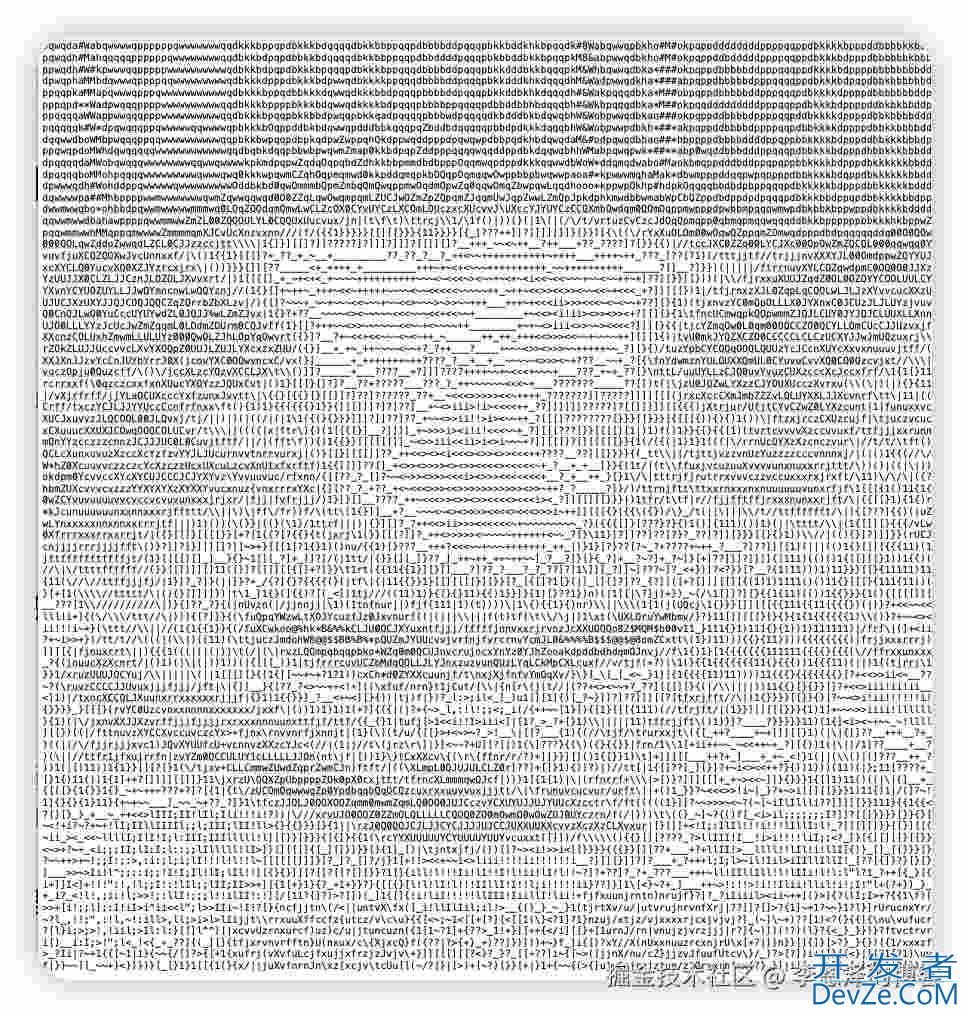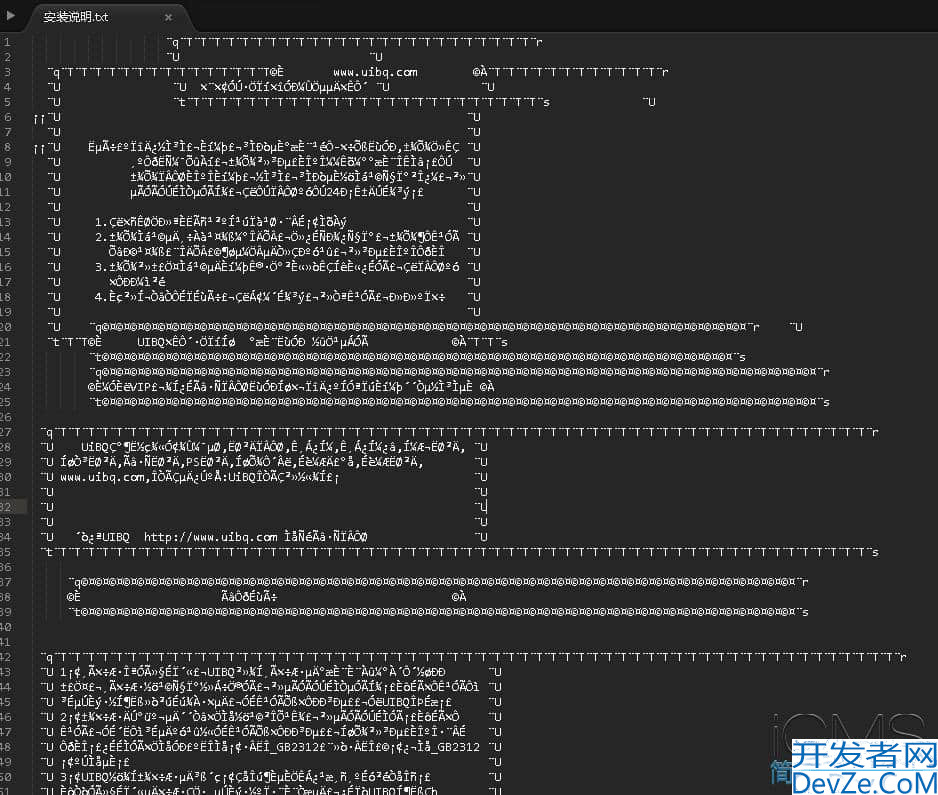Python使用PIL将图片或GIF转为字符画的方法详解
目录
- 图片或GIF转字符画
- 图片转换为黑白字符画
- 将GIF转换为动态彩色字符画
图片或GIF转字符画
红及一时的编程小玩具,将图片转为字符画
接下来通过
python实现,比较好玩
图片转换为黑白字符画
- 安装
pillow库
pip3 install pillow
灰度值:黑白图像中点的颜色深度,范围一般从
0~255,白色为255,黑色为0,所以黑白图片也被成为灰度图像
RBG映射灰度公式
我们要将一张图片的灰度处理,将其中的色彩处理为黑白灰亮度图像
越亮的地方用占位百分比越小的字符来替换处理,比如
|而越暗的地方用占位百分比越大的字符来替换处理,比如
#
创建一个不重复字符序列数据,灰度值越小(越暗)为序列数据开头,越大(越亮)到序列结尾,长度为
90,用来映射256个灰度值,便捷的方法可以直接使用ascii码进行构建定义函数,用来处理
RGB并得出灰度值,根据灰度值,得出一个字符
char_=list("$@B%8&WM#*oahkbdpqwmZO0QLCJUYXzcvunxrjft/\|()1{}[]?_+~<>i!lI;:,\"^`'. ")
def get_char(r,g,b, alpha=256):
'''
r(红),g(绿),b(蓝)
total: 灰度值总大小
return -> str
'''
if alpha == 0:
return ' '
gray = 0.2126 * r + 0.7152 * g + 0.0722 * b #得出灰度值
char_length = len(char_) #字符序列长度
index = (alpha+1) / char_length #总灰度值对应列表索引范围
return char_[int(gray/index)] #返回当前灰度值所对应字符
pillow模块可以打卡图像,并重设图像大小,分析图像像素,定义如下函数,取出图像对应坐标像素
from PIL import Image
def convert_image_to_ascii(origin_path, output_path, width=150, height=80):
"""
将图像转换为ASCII文字并保存到文本文件
:param origin_path: 输入图像路径
:param output_path: 输出文本文件路径
:param width: 输出宽度
:param height: 输出高度
:return: None
"""
# 打开图像,并将其转换为RGBA格式以确保包含alpha通道信息
img = Image.open(origin_path).convert('RGBA')
#Image.NEAREST 代表设置缩放图片的质量
img = img.resize((width,height),Image.NEAREST)
#遍历像素,获得灰度值对应字符
content = ''
for h in range(height):
for w in range(width):
char = get_char(*img.getpixel((w,h)))
content += char
content += '\n' #每一行像素换行追加\n
with open(output_path,'w') as fp:
fp.write(content)
return content
- 运行这段代码,调用
analy_image函数,传入待处理图像路径path及保存之后的文件路径file
比如这样一张图片

- 经过代码处理之后将会变为

- 如果想把文本存储为图片也可以
from PIL import Image
from PIL import Image, ImageDraw, ImageFont
char_ = list(
"$@B%8&WM#*oahkbdpqwmZO0QLCJUYXzcvunxrjft/\|()1{}[]?_+~<>i!lI;:,\"^`'. ")
def get_char(r, g, b, alpha=256):
'''
r(红),g(绿),b(蓝)
total: 灰度值总大小
return -> str
'''
if alpha == 0:
return ' '
gray = 0.2126 * r + 0.7152 * g + 0.0722 * b # 得出灰度值
char_length = len(char_) # 字符序列长度
index = (alpha+1) / char_length # 总灰度值对应列表索引范围
return char_[int(gray/index)] # 返回当前灰度值所对应字符
def convert_image_to_ascii(origin_path, output_path, width=150, height=80):
"""
将图像转换为ASCII文字并保存到文本文件
:param origin_path: 输入图像路径
:param output_path: 输出文本文件路径
:param width: 输出宽度
:param height: 输出高度
:return: None
"""
# 打开图像,并将其转换为RGBA格式以确保包含alpha通道信息
img = Image.open(origin_path).convert('RGBA')
#Image.NEAREST 代表设置缩放图片的质量
img = img.resize((width,height),Image.NEAREST)
#遍历像素,获得灰度值对应字符
content = ''
for h in range(height):
for w in range(width):
char = get_char(*img.getpixel((w,h)))
content += char
content +=www.devze.com '\n' #每一行像素换行追加\n
with open(output_path,'w') as fp:
fp.write(content)
return content
def ascii_art_to_image(ascii_art, output_path, font_path=None, font_size=20):
"""
将ASCII字符艺术转换为图片并保存
:param ascii_art: ASCII字符艺术字符串
:param output_path: 输出图片路径
:param font_path: 字体文件路径,默认为None,表示使用默认字体
:param font_size: 字体大小
:return: None
"""
# 分http://www.devze.com割ASCII艺术字符串为行列表
lines = ascii_art.split('\n')
# 获取最长行的长度和总行数,用于确定图片尺寸
max_line_length = max(len(line) for line in lines)
num_lines = len(lines)
# 设置图片的基本参数
char_width, char_height = font_size, font_size # 假设每个字符宽度和高度相等
margin = 10 # 图片边缘留白
# 创建白色背景的新图像
image = Image.new('RGB',
(max_line_length * char_width + 2 * margin,
num_lines * char_height + 2 * margin),
color='white')
draw = ImageDraw.Draw(image)
try:
# 加载字体
if font_path:
font = ImageFont.truetype(font_path, font_size)
else:
font = ImageFont.load_default()
except IOError:
print("加载字体失败,使用默认字体")
font = ImageFont.load_default()
# 在图像上绘制ASCII艺术文字
for i, line in enumerate(lines):
draw.text((margin, margin + i * char_height),
line, fill='black', font=font)
# 保存图像
image.save(output_path)
print(f"已保存图片至 {output_path}")
path = '1.jpg'
file = '1.txt'
content_str = convert_image_to_ascii(path, '1.txt')
ascii_art_to_image(content_str, '1_ASCII.jpg')
- 完整代码
from PIL import Image
char_ = list(
"$@B%8&WM#*oahkbdpqwmZO0QLCJUYXzcvunxrjft/\|()1{}[]?_+~<>i!lI;:,\"^`'. ")
def get_char(r, g, b, alpha=256):
'''
r(红),g(绿),b(蓝)
total: 灰度值总大小
return -> str
'''
if alpha == 0:
return ' '
gray = 0.2126 * r + 0.7152 * g + 0.0722 * b # 得出灰度值
char_length = len(char_) # 字符序列长度
index = (alpha+1) / char_length # 总灰度值对应列表索引范围
return char_[int(gray/index)] # 返回当前灰度值所对应字符
def analy_image(path, file):
"""
path: 处理图像路径
file: 处理后的保存文件
return -> None
"""
img = Image.open(path)
width = 80
height = 80
img = img.resize((width, height), Image.NEAREST)
# Image.NEAREST 代表设置缩放图片的质量
# 遍历像素,获得灰度值对应字符
content = ''
for h in range(height):
for w in range(width):
ch编程客栈ar = get_char(*img.getpixel((w, h)))
# img.getpixel(w,h) 获取对应坐标像素
content += char
content += '\n' # 每一行像素换行追加\n
print(content)
with open(file, 'w') as fp:
fp.write(content)
将GIF转换为动态彩色字符画
思路很简单,将
GIF图片处理为一帧一帧的单独图片,再将单独图片灰度处理搞成字符图片,像上面这样,最终再上色并且把一阵一阵的字符图片组合成一个字符GIF
from PIL import Image,jsImageDraw,ImageFont
import os
from time import sleep
import imageio
char_ = list("$@B%8&WM#*oahkbdpqwmZO0QLCJUYXzcvunxrjft/\|()1{}[]?-_+~<>i!lI;:,\"^`'. ")
#"MNHQ$OC67+>!:-. "
def get_char(r,g,b,alpha=256):
'''
r(红),g(绿),b(蓝)
total: 灰度值总大小
return -> str
'''
if alpha == 0:
return ''
gray = 0.2126 * r + 0.7152 * g + 0.0722 * b #得出灰度值
char_length = len(char_) #字符序列长度
index = (alpha+1) / char_length #总灰度值对应列表索引范围
return char_[int(gray/index)] #返回当前灰度值所对应字符
def gif2png(path='test.gif'):
'''
path: GIF 图像路径
该函数拆分GIF为单独的每一张PNG图片
'''
img = Image.open(path)
work_path = os.getcwd() #当前工作路径
cache_dir = os.path.join(work_path,'cache')
if not os.path.exists(cache_dir):
#如果不存在保存单独每一帧图片的目录,则创建该目录
os.mkdir(cache_dir)
while True:
try:
current = img.tell() #获取当前帧位置
file_name = os.path.join(cache_dir,str(current)+'.png')
img.save(file_name)
img.seek(current+1) #向下一帧读取
php except EOFError:
#GIF读取完毕
break
return current
def analy_image(pic_id):
"""
path: 处理图像路径
file: 处理后的保存文件
return -> None
"""
cache_dir = os.path.join(os.getcwd(),'cache')
path = os.path.join(cache_dir,'%d.png' % (pic_id))
img = Image.open(path).convert('RGB')
#GIF处理后的单帧图片需要转换为RGB格式,否则会报错
pic_width,pic_height = img.width,img.height
width = int(pic_width / 6)
height = int(pic_height / 12)
img = img.resize((width,height),Image.NEAREST)
#Image.NEAREST 代表设置缩放图片的质量
#遍历像素,获得灰度值对应字符
content = ''
colors = []
for h in range(height):
for w in range(width):
px = img.getpixel((w,h))
char = get_char(px[0],px[1],px[2], px[3] if len(px) > 3 else 256)
colors.append( (px[0],px[1],px[2]) )
#img.getpixel(w,h) 获取对应坐标像素
content += char
content += '\n' #每一行像素换行追加\n
colors.append( (255,255,255) )
print(content)
return content,colors,pic_width,pic_height
def text2png(content,colors,pic_width,pic_height,pic_id):
'''
将输出的图片字符文本转换为png
'''
work_path = os.getcwd() #当前工作路径
content_dir = os.path.join(work_path,'content')
if not os.path.exists(content_dir):
#如果不存在保存单独每一帧图片的目录,则创建该目录
os.mkdir(content_dir)
txt_img = Image.new("RGB", (pic_width,pic_height), (255,255,255))
canvas = ImageDraw.Draw(txt_img) #创建一个可以在给定图像上绘图的对象
font = ImageFont.load_default().font
x = 0
y = 0
font_w,font_h = font.getsize(content[1]) #字体的宽高
for i in range(len(content)):
if content[i] == '\n':
x = -font_w #每次初始化横纵坐标
y += font_h
canvas.text( (x,y), content[i], colors[i])
x += font_w # 追加一个字体的像素
txt_img.save(os.path.join(content_dir,'%d.png' % (pic_id)))
def png2gif(_id,dir_name='content',duration=5 / 130):
'''
将之前处理好的字符png图片组合成GIF图像
通过imageio模块处理合并
'''
path = os.path.join(os.getcwd(),dir_name)
images = []
for pic_id in range(_id):
#遍历取出每一张处理后的字符图片id值
images.append(imageio.imread(os.path.join(path,'%d.png' % pic_id) ) )
#从文件中读入数据
imageio.mimsave(os.path.join(os.getcwd(),'fin.gif'), images, duration=duration)
#保存路径、png图片数据列表、合并帧频率
def main():
path = input(':')
_id = gif2png(path)
for pic_id in range(_id+1):
content,colors,pic_width,pic_height = analy_image(pic_id)
text2png(content,colors,pic_width,pic_height,pic_id)
sleep(5 / 130)
os.system('cls')
png2gif(_id)
if __name__ == '__main__':
main()
- 来看这样一张
GIF图片

- 他会变成这样

以上就是Python使用PIL将图片或GIF转为字符画的方法详解的详细内容,更多关于Python PIL图片或GIF转字符画的资料请关注编程客栈(www.devze.com)其它相关文章!





 加载中,请稍侯......
加载中,请稍侯......
精彩评论